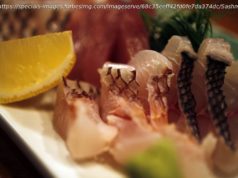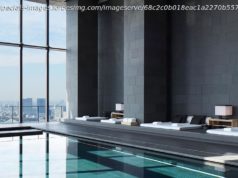His legacy seems to be one building in Tokyo. But most of the country’s Modernism can be traced back to him — and the struggle to place his ideas into Japanese identity.
IT DOES NOT announce itself as a major building. In Ueno, at the northern end of old Tokyo, stands a relatively small concrete box, hoisted on slim columns. It is set off from the rest of the park by a wide gray plaza, demanding a solemn approach. As you near it, the flat expanse of the facade begins to differentiate itself into cladding panels, textured with pebbled aggregate. An off-center stairway juts out, a symbolic ascendance into a temple of art. This is the National Museum of Western Art in Tokyo, erected in 1959, and it is, incredibly enough, the only building to be designed by Charles-Édouard Jeanneret, better known by his nom de plume “Le Corbusier,” in all of East Asia.
The austerity of its presentation hides special, humanizing characteristics in its interior such as a characteristically Corbusian ramp that ascends to the second-floor gallery space. Built to house the collection of an early 20th-century Japanese industrialist, with special strengths in late 19th-century French art, the National Museum of Western Art employed three local architects. Their names — Junzo Sakakura, Takamasa Yoshizaka and, above all, Kunio Maekawa — would become hallowed in the emerging pantheon of Japanese Modernists. They had trained with Le Corbusier in Paris, and they were early exponents of his ideas. In Japan, they all assumed a position of pre-eminence, their own acolytes cementing the hegemony of Modernism over other forms of Japanese architecture.
The story is not well known. To look at just a few standard accounts of Le Corbusier’s life and work — Kenneth Frampton’s “ Le Corbusier: Architect of the Twentieth Century,” Charles Jencks’s “ Le Corbusier and the Continual Revolution in Architecture,” or Nicholas Fox Weber’s authoritative biography — is to search in vain for any reference to the building, or for any mention of the association between Le Corbusier and Japan. (The story of the building is well told, however, in Jonathan Reynolds’s pioneering study, “ Maekawa Kunio and the Emergence of Japanese Modernist Architecture .”) This absence both occludes the extent of his influence and testifies, obliquely, to the enduring anxiety of Japanese Modernists, and Japanese architects more generally, over the scope of his project.
This anxiety can be seen even before Maekawa and the other Modernists began building anything. In 1929, a monthly Japanese architecture magazine, Kokusai Kenchiku (International Architecture), devoted two entire issues to the work of Le Corbusier. Its May issue contained 15 articles on the architect; its June issue presented 11 more, among them translations from English-speaking critics and from the master himself. He was then an emerging Modernist, possibly as known for his writing (still untranslated into Japanese at that point) as for the comparatively small, but profoundly disconcerting, output of his Paris atelier. Like other Modernist architects, he sought to simplify the art of building into a few cardinal points. The radical changes Le Corbusier would bring to architecture were already in evidence in buildings such as the canonical Villa Savoye (built between 1928 and 1931) outside of Paris: the “free plan” that banished load-bearing structures from central spaces; the transformation of the reinforced concrete column-beam system into a dynamic exhibition of technological prowess. Thanks to the overwhelming clarity of his positions, the bewitching nature of his epigrammatic style and the already-powerful international movement for Modernism, the impact he had on a rising generation of Japanese architects would prove to be immense.
But it would be the nature of that impact to be felt only in conditions of overwhelming ambivalence. The architect Yoshiro Taniguchi exemplified the emotional nature of the Japanese reception of Le Corbusier. “How is it that this man Le Corbusier can grasp hold of my heart, overpower it, and not let go?” he wrote in his contribution to one of the Kokusai Kenchiku symposia. Bound up in Taniguchi’s response are the deep contradictions that would characterize much of Japanese Modernism in the years to come: the desire to embrace what was globally seen as modernity in architecture, while also retaining a sense of what were widely seen, nationally but also vaguely, as gestures that exuded “Japaneseness,” or that were typically “Japanese,” such as the use of traditional wooden-beam structures, or the inclusion of pitched roofs. The debate over Japaneseness was itself in part a Western import, since the mid-19th-century taste, of Impressionists and Art Nouveau enthusiasts, for japonaiserie — for example, the woodblock prints of Hokusai and Hiroshige, folding screens, ivory medicine boxes — transformed the self-perception of the Japanese. As the architect Arata Isozaki wrote, in “ Japan-ness in Architecture, ” the “concepts perceived to underlie” the production of Japanese work — “simplicity, humility, purity, lightness and shibusa (sophisticated austerity)” — became markers of Japaneseness. “Modernism in architecture,” Isozaki continues, “was introduced to Japan concurrently with efforts to construct the problematic of Japan-ness.”
Though Le Corbusier helped master plan the city of Chandigarh in India, and epigones pursued this vision in Cambodia and Sri Lanka, it was Japan that would take up Corbusianism most powerfully. What was attractive about Le Corbusier was also what was repellent: his deracinated formalism; the reproducibility of his plans; his determination to have architecture exhibit the technological innovations of its era. Le Corbusier is not necessarily the first name that comes to mind when one thinks of Japanese architecture. But to understand its trajectory, he may be the most important and emblematic.
ON A RECENT trip to Tokyo, I stayed in the International House of Japan, a membership institution and academic guesthouse designed by Maekawa (along with Sakakura and Junzo Yoshimura). Lightness infuses this surpassingly tranquil 1955 structure, situated between the districts of wealthy Azabu‑Juban and neon-sodden Roppongi: the main building’s heavy, boxlike concrete frame perforated by balconies, fronting rooms shielded by shoji screens; its lobby walled in part with soft Oya stone; its tea lounge poised over a Japanese garden, to which floor-to-ceiling windows offer a view. The complex refracted the continuing attempt, by Maekawa and other exponents of Corbusianism, to balance the old and the new. So, too, with Takamasa Yoshizaka’s Inter-University Seminar House (1965), an inverted concrete frustum that is at once technically inspiring and ancient-seeming — recalling, if only through dim mental association, the elementary structures of ruins and villages.
What was it about Le Corbusier’s Modernism that appealed to Japanese architects, who had, behind them, a virtually unbroken tradition of architecture, developed over thousands of years largely in isolation from Europe? In truth, Modernism, whether European or Japanese, developed roots in countries in which the political and economic structures of so-called modernity were felt unevenly, mitigated by the resilience of older, feudal traditions. In his 1981 book “ The Persistence of the Old Regime,” the historian Arno Mayer revealed that, despite the “creative destruction” wrought by capitalism, most Western European nations were, until the successive catastrophes of World War I, the revolutions that followed and World War II, largely agrarian and saddled with aristocratic landowning classes that controlled much of the country’s wealth. Artistic Modernism of all kinds took root in this soil, anxious about the disappearance of the past as well as, paradoxically enough, its unyielding grip. Modernist techniques did not express the spirit of a new confidence, but the violent struggle to displace the aesthetics of the old regime. Dissonance was built into the project from the outset.
In the 1920s, Modern architecture was a new field in Japan. It became distinguished from the work of artisans and general craftsmanship in the late 19th century. Despite, and perhaps a little because of this, Japan’s was the earliest and most thorough engagement with Le Corbusier in all of East Asia: By the early 1930s, many of his most important books had been translated into Japanese, and several Japanese architects returned from stints in his firm to translate his ideas onto Japanese soil. It also would end up being the most lasting. After World War II, in which the Americans destroyed Tokyo in the second most vicious bombing campaign in history (the first was the American bombing of Vietnam), Modernism — especially through the medium of concrete — became the ideology of Japanese reconstruction. And Kenzo Tange, arguably the most influential postwar Japanese architect, who worked in Maekawa’s office and participated in Le Corbusier’s Congrès Internationaux d’Architecture Moderne (CIAM), took his cue from Le Corbusier’s sculptural, expressionistic use of concrete, and he pursued and expanded Le Corbusier’s early interest in comprehensive city planning.
Facing the National Museum of Western Art is the Tokyo Metropolitan Festival Hall (1961), one of the major works of Kunio Maekawa and one of the great buildings of the postwar era. Maekawa had joined Le Corbusier’s firm as an impressionable 22 year old, and he saw the Villa Savoye as it was being constructed. Le Corbusier’s struggles to plant Modernism in Europe would inspire Maekawa, who faced an equally intransigent establishment in Japan; more than anyone else, his work exemplified the innovations and compromises of Japanese Modernism in its early days. It makes sense, then, that one of his major works would stand across from Le Corbusier’s building, as if in dialogue with it. The Festival Hall exceeds the National Museum of Western Art in breadth, its heavy horizontal span accentuated by an enormous overhanging concrete roof, its eaves upturned.






